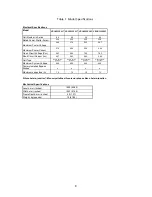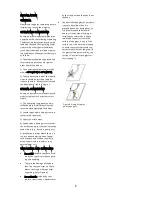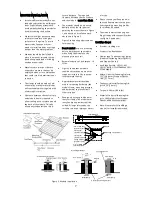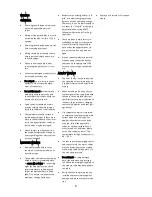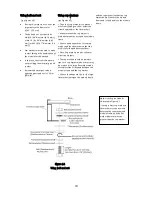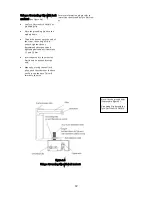
8
WIRING
GENERAL
All wiring should be done in accord-
ance with applicable electrical
codes.
Wiring methods should be in accord-
ance with the NEC in USA or CEC in
Canada.
All wiring should be done by a quali-
fied, licensed professional.
Wiring should be protected to help
ensure personal safety and to pre-
vent its damage.
Please connect each cable after
confirming the polarity of it is cor-
rect.
Connectors between modules must
be inserted until they click.
Do not put too much stress on con-
nectors in order to avoid detach-
ment of connectors.
Do not disconnect terminals while
modules generate electricity and
connect electrical load to avoid the
hazard of electrical shock.
Cable conduits should be used in
locations where the wiring is inac-
cessible to children or small animals.
These modules contain factory in-
stalled bypass diodes. If these mod-
ules are connected each other incor-
rectly, the bypass diodes, cables, or
junction box may be damaged.
Please contact your Panasonic Au-
thorized Representative with ques-
tions regarding other electrical con-
nections if needed.
MODULE WIRING
All modules connected in series
should be of the same model num-
ber and/or type.
The number of modules that can be
wired in series is recommended to
be seven (7) or fewer. If connecting
eight (8) modules in series, check
local temperature conditions and
follow the National Electric Code
(690.7) to ensure compliance with
maximum voltage limitations.
Modules are not designed for “off-
grid” or battery charging systems,
because of their operating voltage.
Therefore, it is not recommended to
use them for “off-grid” or charging
batteries without using MPPT
(Maximum Power Point Tracking)
controller.
These modules contain factory in-
stalled bypass diodes. If these mod-
ules are incorrectly connected to
each other, the bypass diodes, ca-
ble, or junction box may be dam-
aged.
Do not connect modules in parallel
without using connection devices
that connect to appropriate FUSE
for each series string or each mod-
ule.
ARRAY WIRING
The term “array” is used to describe
the assembly of several modules on
a support structure with associated
wiring.
When installing a PV array, the sys-
tem design must be completed with
reference to the module electrical
specifications for proper selection of
inverters, fuses, breakers, charging
controllers, batteries and other stor-
age devices.
Use copper wire which is insulated
to withstand the maximum possible
system open circuit voltage. For
applications where wire conduits
are used, follow the applicable
codes for outdoor installation of
wires in conduits. Minimum diame-
ter of wire conduit is 4 mm
2
. The
temperature rating of conductor is –
40
~
90
℃.
In order to avoid submerging cables
and connectors in the water, cables
must be fixed either to the module
frame using cable fixing holes or to
the mounting structure.
Do not insert PV cable between
back side and mounting structure
rail. When snow weight is applied to
the module, load may be applied to
the cable.
Verify that all fittings are properly
installed to protect cables against
damage and prevent moisture intru-
sion.
Check your local codes for require-
ments.




